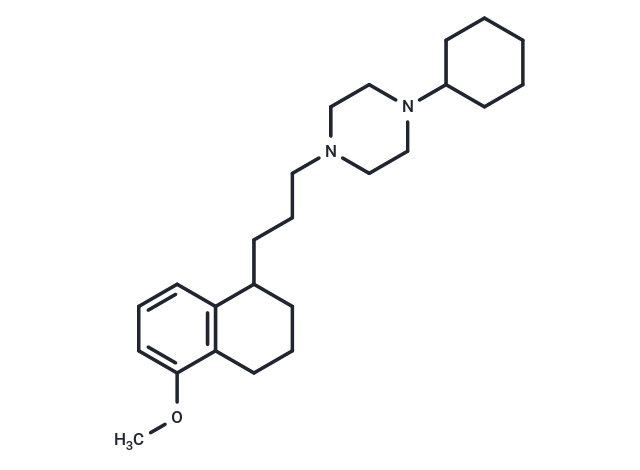 Your shopping cart is currently empty
Your shopping cart is currently empty

PB28 is a cyclohexylpiperazine derivative that functions as a potent and highly selective agonist of the sigma 2 (σ2) receptor, exhibiting a Ki (binding affinity) of 0.68 nM. At the same time, PB28 acts as an antagonist of the sigma 1 (σ1) receptor, with a Ki of 0.38 nM. PB28 demonstrates a lower affinity for other receptors. It effectively inhibits electrically evoked twitch in both the guinea pig bladder (EC50 value of 2.62 μM) and ileum (EC50 value of 3.96 μM). Moreover, PB28 exhibits the ability to modulate protein-protein interaction between SARS-CoV-2 and human cells. Additionally, PB28 triggers caspase-independent apoptosis and possesses significant antitumor activity.

| Pack Size | Price | USA Warehouse | Global Warehouse | Quantity |
|---|---|---|---|---|
| 25 mg | $1,520 | Inquiry | Inquiry |
| Description | PB28 is a cyclohexylpiperazine derivative that functions as a potent and highly selective agonist of the sigma 2 (σ2) receptor, exhibiting a Ki (binding affinity) of 0.68 nM. At the same time, PB28 acts as an antagonist of the sigma 1 (σ1) receptor, with a Ki of 0.38 nM. PB28 demonstrates a lower affinity for other receptors. It effectively inhibits electrically evoked twitch in both the guinea pig bladder (EC50 value of 2.62 μM) and ileum (EC50 value of 3.96 μM). Moreover, PB28 exhibits the ability to modulate protein-protein interaction between SARS-CoV-2 and human cells. Additionally, PB28 triggers caspase-independent apoptosis and possesses significant antitumor activity. |
| Targets&IC50 | σ2 receptor:0.68 nM (Ki), σ1 receptor:0.38 nM (Ki) |
| In vitro | PB28 treatment at concentrations of 15-25 nM for 24-48 hours on MCF7 and MCF7 ADR cells results in G0-G1 phase accumulation in a manner that is both time and concentration independent[1]. This compound exhibits greater affinity for the σ2 receptor (with K i values of 0.28 nM for MCF7 cells and 0.17 nM for MCF7 ADR cells) compared to the σ1 receptor (13.0 nM for MCF7 cells and 10.0 nM for MCF7 ADR cells)[1]. Moreover, PB28 effectively inhibits cell growth in these cell lines, showing IC50s of 25 nM for MCF7 and 15 nM for MCF7 ADR cells after a 2-day treatment[1]. It triggers apoptosis via a caspase-independent pathway and significantly downregulates P-glycoprotein (P-gp) expression in a concentration- and time-dependent manner, with reductions around 60% for MCF7 and 90% for MCF7 ADR cells[1]. Additionally, PB28 exhibits both antiproliferative and cytotoxic effects in C6 rat glioma and SK-N-SH human neuroblastoma cell lines[1]. Cell cycle analysis further corroborates the G0-G1 phase accumulation in MCF7 and MCF7 ADR cells at 25 nM and 15 nM concentrations, respectively, over 24 and 48 hours, highlighting the treatment's independence from time and concentration[1]. |
| In vivo | PB28 administration (10.7 mg/mL; intraperitoneal injection; daily; for two weeks) in C57BL/6 female mice, aged 10 weeks and injected with Panc02 cells, inhibits tumor growth and confers a survival advantage in mice with a Panc02 tumor burden. |
| Molecular Weight | 370.581 |
| Formula | C24H38N2O |
| Cas No. | 172906-90-0 |
| Smiles | COc1cccc2C(CCCN3CCN(CC3)C3CCCCC3)CCCc12 |
| Relative Density. | 1.032 g/cm3 (Predicted) |
| Storage | Powder: -20°C for 3 years | In solvent: -80°C for 1 year | Shipping with blue ice/Shipping at ambient temperature. |
| Size | Quantity | Unit Price | Amount | Operation |
|---|

Copyright © 2015-2026 TargetMol Chemicals Inc. All Rights Reserved.